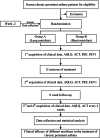Acupuncture for chronic persistent asthma based on the theory of Meridian-viscera Association: study protocol for a multi-center randomized controlled trial in China
- PMID: 33407788
- PMCID: PMC7789474
- DOI: 10.1186/s13063-020-04844-8
Acupuncture for chronic persistent asthma based on the theory of Meridian-viscera Association: study protocol for a multi-center randomized controlled trial in China
Abstract
Background: Acupuncture is effective in symptom and quality of life improvement of chronic asthma, but the efficacy differences between different acupoints are uncertain. In terms of the theory of Meridian-viscera Association, the study aims to investigate the different effectiveness between acupoints in Lung meridian and the acupoints in Heart meridian, so as to provide the evidence to develop a better prescription of the acupuncture treatment of chronic persistent asthma.
Methods: This study is a multicentral randomized controlled trial. A total of 68 chronic persistent asthma patients will be randomly allocated into two groups: the Lung meridian group and the Heart meridian group. This trial will include a 2-week baseline period, a 4-week treatment period with 12 sessions' acupuncture, and an 8-week follow-up period. The primary outcome is the Asthma Quality of Life Questionnaire (AQLQ). Secondary outcomes are the Asthma Control Test (ACT), Peak Expiratory Flow (PEF), and Forced Expiratory Volume in 1 s (FEV1). The AQLQ and ACT will be collected at baseline, week 4, week 8, and week 12 after randomization. PEF, FEV1, the Self-rating Anxiety Scale (SAS), and the Self-rating Depression Scale (SDS) will be assessed at baseline and week 4.
Discussion: The results will provide evidence for acupuncture prescription selection and the clinical efficacy improvement. The results of this trial will also be used to determine whether or not a full definitive trial will go ahead, which will further confirm the theory of Meridian-viscera Association.
Trial registration: Chinese Clinical Trial Registry ( http://www.chictr.org.cn/showproj.aspx?proj=43803 ) ChiCTR1900027284. Registered on 7 November 2019.
Keywords: Acupuncture; Chronic persistent asthma; Protocol; Randomized controlled trial; Theory of Meridian-viscera Association.
Conflict of interest statement
The authors declare that they have no competing interests.
Figures


Similar articles
-
Acupuncture for chronic stable angina pectoris based on the theory of Meridian-Viscera Association: study protocol for a multicenter randomized controlled trial.Trials. 2020 Nov 6;21(1):915. doi: 10.1186/s13063-020-04836-8. Trials. 2020. PMID: 33158451 Free PMC article.
-
Effect of acupuncture and its influence on cerebral activity in patients with persistent asthma: study protocol for a randomized controlled clinical trial.Trials. 2020 May 14;21(1):406. doi: 10.1186/s13063-020-04319-w. Trials. 2020. PMID: 32410641 Free PMC article.
-
Efficacy of acupuncture based on acupoint combination theory for irritable bowel syndrome: a study protocol for a multicenter randomized controlled trial.Trials. 2021 Oct 19;22(1):719. doi: 10.1186/s13063-021-05432-0. Trials. 2021. PMID: 34666815 Free PMC article.
-
Mechanism of acupuncture regulating visceral sensation and mobility.Front Med. 2011 Jun;5(2):151-6. doi: 10.1007/s11684-011-0129-7. Epub 2011 Jun 22. Front Med. 2011. PMID: 21695619 Review.
-
Using Traditional Chinese Medicine to Relieve Asthma Symptoms: A Systematic Review and Meta-Analysis.Am J Chin Med. 2019;47(8):1659-1674. doi: 10.1142/S0192415X1950085X. Epub 2019 Dec 3. Am J Chin Med. 2019. PMID: 31795745
Cited by
-
Research on the Mechanism and Application of Acupuncture Therapy for Asthma: A Review.J Asthma Allergy. 2024 May 29;17:495-516. doi: 10.2147/JAA.S462262. eCollection 2024. J Asthma Allergy. 2024. PMID: 38828396 Free PMC article. Review.
-
Effect of Thermal Stimulation of a Selected Acupuncture Point danzong on Pulmonary Function in Patient with Bronchial Asthma: A Case Report.Integr Med (Encinitas). 2023 May;22(2):32-34. Integr Med (Encinitas). 2023. PMID: 37363149 Free PMC article.
References
-
- Global Initiative for Asthma . Global strategy for asthma management and prevention. 2019.
-
- GBD 2015 Chronic Pespiratory Disease Collaborators Global, regional, and national deaths, prevalence, disability-adjusted life years, and years lived with disability for chronic obstructive pulmonary disease and asthma, 1990-2015: a systematic analysis for the Global Burden of Disease Study 2015. Lancet Respir Med. 2017;5(9):691–706. doi: 10.1016/S2213-2600(17)30293-X. - DOI - PMC - PubMed
Publication types
MeSH terms
Grants and funding
LinkOut - more resources
Full Text Sources
Other Literature Sources
Medical

